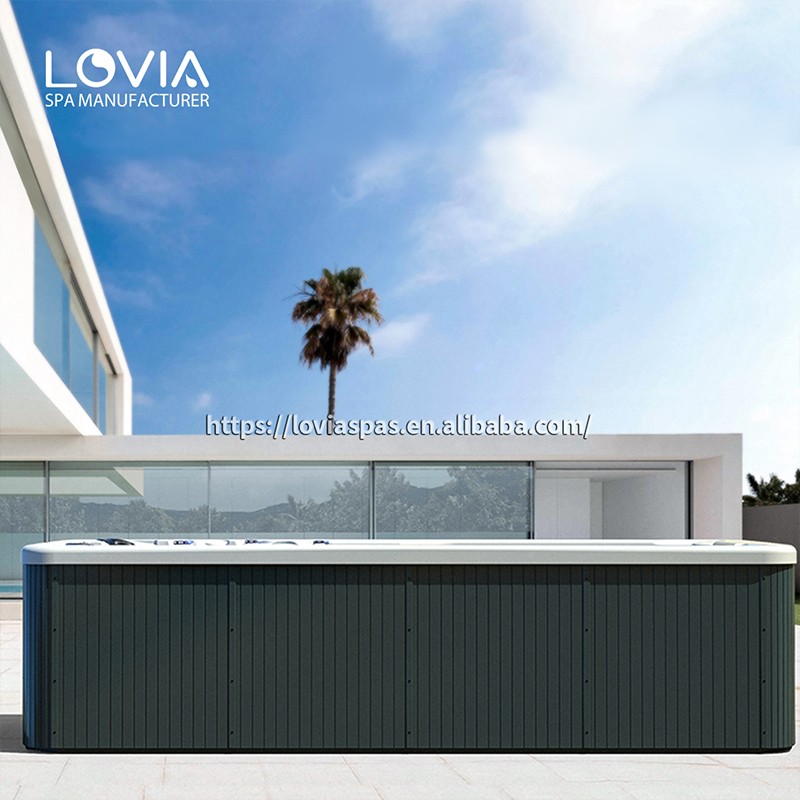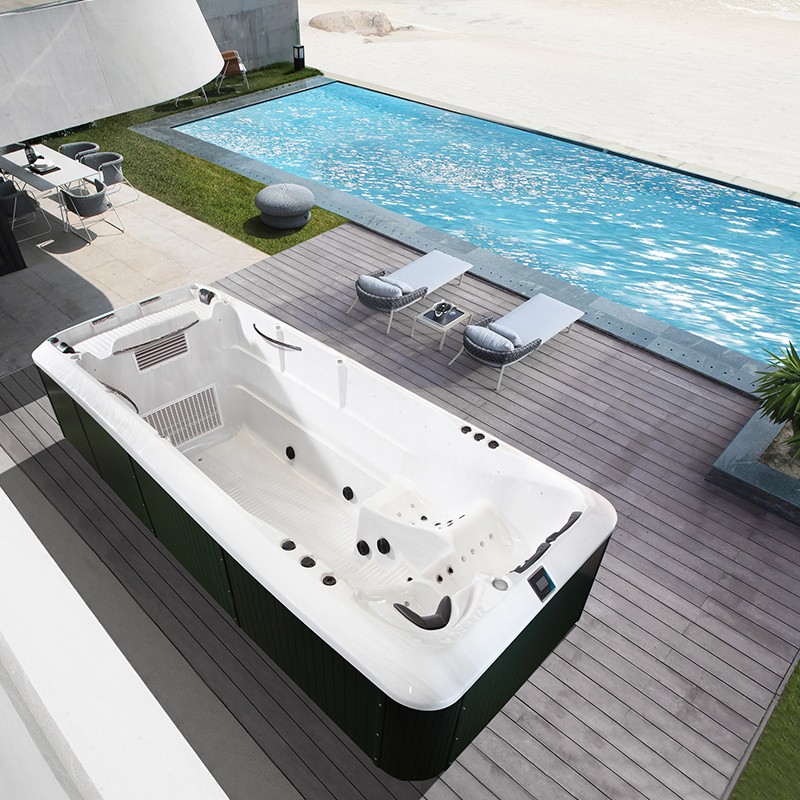
Is the main body of the swim spa tub insulated?
2025-07-02 15:30In the field of water leisure and home fitness, swim spa tubs are widely favored for their design that integrates the dual functions of swimming and hydrotherapy. However, for users, in addition to function and size, another core concern is the thermal efficiency of the equipment, that is, whether the main body of the swim spa tub has good thermal insulation performance? What are the advantages of its thermal insulation materials?
This is not only related to the comfort experience in daily use, but also directly affects the energy consumption level and maintenance cost. Therefore, this article will conduct a systematic analysis around the "thermal insulation of the main body of the swim spa tub" and deeply explore the types and advantages of its common thermal insulation materials.

Why does a swim spa tub need thermal insulation?
1. Large water capacity and high risk of heat loss
The water capacity of a swim spa tub is usually between 4,000 and 10,000 liters, which is much higher than a standard hot tub. Therefore, the energy required to heat to the ideal temperature (such as 32~38°C) is much greater than that of a general bathtub. In a cold environment, if the swim spa tub does not have a good insulation system, the heat will be lost quickly, resulting in frequent heating and high energy consumption.
2. Most of them are installed outdoors and are greatly affected by the ambient temperature difference
Most swim spa tubs are installed in courtyards, terraces or outdoor platforms, so they are inevitably affected by factors such as external air temperature, wind speed, and humidity. The temperature difference at night and rainy and snowy weather will cause the heat to be lost quickly.
3. Continuous heating will affect the life and cost of the equipment
If the swim spa tub lacks a good insulation structure, the system must frequently run the heating device to maintain the set water temperature. This not only leads to a significant increase in energy consumption, but also accelerates the wear of core components such as heaters and pump bodies.
Is the main body of the swim spa tub insulated?
1. The answer is yes
Mid- to high-end swim spa tubs under modern manufacturing standards generally have a multi-layer insulation structure, and their main body and piping system are specially designed for heat retention. In other words, the main body of the swim spa tub is insulated, and the insulation effect has even become one of the core competitive factors among manufacturers.
2. Where is the heat preservation of swim spa?
The heat preservation of swim spa tub is not realized in a single part, but involves the coordinated design of multiple structural links, including but not limited to:
· Bathtub shell insulation: the outermost main shell layer.
· Inner tank foam filling: the inner and bottom of the tank are filled with dense foam.
· Pipeline wrapping layer: water pipelines are wrapped with insulation materials.
· Equipment compartment insulation cover: heat insulation treatment of water pumps and electric heaters.
· Top heat protection cover: used to prevent hot air from evaporating through the water surface.
These systems are combined to form an overall insulation system, so that heat energy can be effectively isolated in multiple directions and reduce losses.

What are the common insulation materials for swim spa tub?
1. Polyurethane Foam
· Introduction: Polyurethane foam is a high-density closed-cell foam material, widely used in the fields of cold and hot insulation, building insulation and hull sound insulation.
Advantages:
· High thermal resistance coefficient: low thermal conductivity and slow heat conduction rate.
·High strength and fit: can be directly sprayed or poured on the surface of the tank to fill the gaps tightly.
·Waterproof and corrosion-resistant: the foam itself does not absorb water and is not easy to deform.
·Long service life: high stability and not easy to fall off due to aging.
In swim spa tubs, polyurethane foam is usually used as the main insulation layer between the main shell and the inner tank, with a thickness ranging from 3cm to 8cm, depending on the product grade and brand.
2. Fiberglass + foam composite material
·Introduction: The composite insulation method of fiberglass outer shell + foam inner layer is a common structural mode in the industry.
Advantages:
·High structural strength: the fiberglass layer provides support and the foam layer provides insulation.
·Moldable: suitable for complex curved surface tanks.
·Strong thermal inertia: can slowly dissipate heat over a long period of time.
The advantage of composite materials lies in the balance between structure and insulation, and they are widely used in mid-range swim spa tubs.
3. Polyethylene closed-cell foam (PE Foam)
·Introduction: PE foam has good resilience and lightweight structure, and is often used for water pipeline wrapping.
Advantages:
·Good flexibility: suitable for irregular water pipe shapes.
·Dual functions of heat resistance and shock resistance.
·Moderate cost, environmentally friendly and non-toxic.
Although this type of material cannot be used alone as the main shell insulation layer of the bathtub, it plays an important role in auxiliary structures (such as pipes and connecting valves).
4. Infrared reflective insulation foil (Reflective Thermal Foil)
·Introduction: This is a multi-layer composite material, including reflective aluminum film and polyester insulation layer, the main function is to reflect thermal radiation.
Advantages:
·Block radiant heat loss.
·Thin and efficient, suitable for use in narrow spaces.
·Can be combined with other foam materials to form a composite insulation layer.
Commonly used in the insulation structure at the bottom of the swim spa tub or inside the cabin.
Benefits of good thermal insulation of swim spa tub
1. Significant energy saving effect
Hot water maintains a high temperature per unit time, reducing the heating frequency, thereby greatly reducing energy consumption.
Taking an average of 2 hours of daily use as an example, a well-insulated swim spa tub can save about 1~3 kWh of electricity per day compared to an ordinary model, and the long-term cumulative energy saving effect is significant.
2. Longer water temperature and better user experience
Even when the heating system is turned off, a well-insulated swim spa tub can still maintain water temperature for several hours, which is especially suitable for long-term bathing in winter or nighttime use.
3. Extend equipment life
The heating system reduces mechanical fatigue by reducing frequent startup, and the working life of the electric pump and electric heater can be effectively extended.
4. Reduce operating noise
The foam material also has a good acoustic damping effect, which helps to isolate the operating sound of the electric pump and the circulation system, and enhance the user's quiet experience.

Insulation indicators that users should pay attention to when purchasing swim spa tubs
1. Check the R value or K value in the swim spa tub product parameters
·R value: thermal resistance value, the higher the value, the better the insulation performance;
·K value: thermal conductivity, the lower the value, the slower the heat loss.
The R value of a high-quality swim spa tub can reach 15~20 or more, indicating that its heat loss efficiency is extremely low.
2. Pay attention to the manufacturing process and number of layers
·Is it a multi-layer structure;
·Is high-density foam used;
·Is there a pipe coating layer;
·Is there an independent insulation cover for the equipment compartment.
3. Avoid cheap products without insulation or filled with only low-density foam
Low-cost swim spa tub products often shrink in the thickness and quality of the insulation layer, resulting in high energy consumption and low comfort.
Do you offer promotional deals or discounts for bulk orders?
Yes, we frequently offer Discounts and Promotions on Wholesale and bulk purchases. Lovia Spa, a division of Guangzhou HuanTong Industrial, takes pride in helping partners expand with competitively priced, high quality spa and hot tub solutions. Our Guangzhou-based factory is optimized for scale, enabling efficient production for even large international orders.
